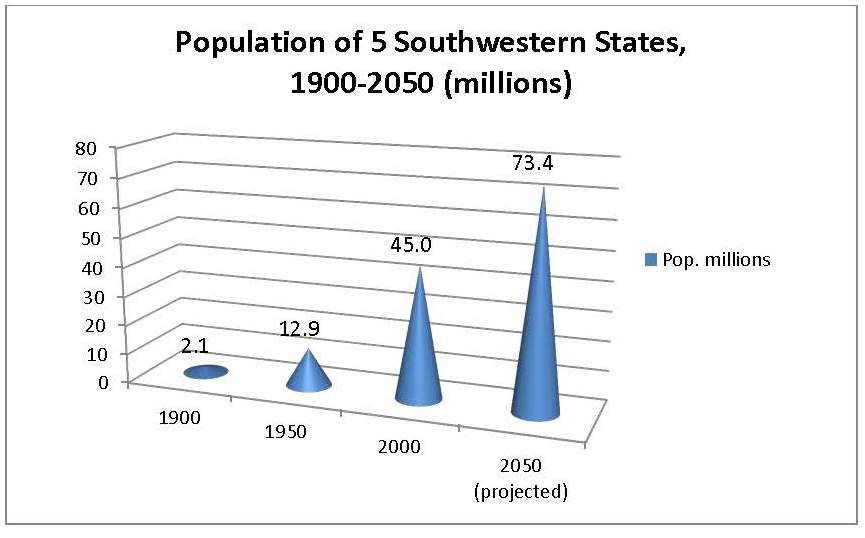Exploding Southwest Population on Collision Course with Drought Water scarcity vs. perpetual growth
Published on July 12th, 2013
In his classic 1986 book Cadillac Desert, the late author Marc Reisner argued that explosive population growth and development in the American Southwest were on an inevitable collision course with the fundamental hydrological realities of an implacably arid region.
Life-giving water courses through natural ecosystems and human economies like blood through a living organism. Cadillac Desert recounts dramatically how patterns of natural water flow in the Southwest were fundamentally reengineered to serve human aims. Defying nature, water was compelled to flow uphill and during dry seasons when normally it was absent.
Subtitled The American West and its Disappearing Water, Cadillac Desert presented the history of two powerful federal bureaucracies in the West: the Bureau of Reclamation and the Army Corps of Engineers. Both agencies are loved and loathed in equal measure. Reisner’s book chronicles their grand scheme to harness and exploit Western water sources – all in the service of relentless human ambition first to settle this once nearly empty land and then to build upon it an ever greater and enduring empire.
For the past century, as shown in the chart, California, Nevada, Utah, Arizona, and New Mexico have experienced some of the country's fastest, most unsustainable population growth. The Census Bureau and state demographic agencies all project continued substantial growth as far as the eye can see.
 Whether one laments or celebrates this growth, none of it would have been possible without massive water projects – dams, reservoirs, aqueducts, and the like – to capture, impound and move this most precious of resources from where nature put it to where people need it. Where people need it is not necessarily where people live – vast quantities of water are used to irrigate crops away from towns and cities. (But then these crops, 70-90% water by weight, are indeed transported to the cities to feed their burgeoning populations.)
Whether one laments or celebrates this growth, none of it would have been possible without massive water projects – dams, reservoirs, aqueducts, and the like – to capture, impound and move this most precious of resources from where nature put it to where people need it. Where people need it is not necessarily where people live – vast quantities of water are used to irrigate crops away from towns and cities. (But then these crops, 70-90% water by weight, are indeed transported to the cities to feed their burgeoning populations.)
Now, a tenacious, withering drought is bringing the issues raised in Cadillac Desert to a boil. The Colorado River is the lynchpin of this crucial, colossal, complex system of water works. And the Colorado River is in dire straits. By the end of the year, if the drought holds, the river’s two largest reservoirs – Lake Powell (impounded by the Glen Canyon Dam upstream of the Grand Canyon), and Lake Mead (impounded by Hoover Dam near Las Vegas) – will only be at 45% capacity, the lowest they have been in 45 years.
And the future looks grim. This past December, the federal government released a 3-year study warning that drought, climate change and population growth are rapidly outpacing the ability of the Colorado River to supply water. It reported a “troubling trajectory” of increasing water demand colliding with decreasing water supply.
Of these three factors underlying the crisis, only population growth is within our ability to modify directly. But do you think this was even on the table when 40-odd water agency officials, environmentalists, farmers, and Indian tribal leaders met recently in San Diego to consider how to address the crisis?
Most certainly not. Instead they discussed water sales from agricultural to municipal interests and devising more approaches for squeezing still more water from one of the most overexploited rivers on earth.
In the opening pages of Cadillac Desert, author Reisner chose to include the poem “Ozymandias” by Percy Bysshe Shelley (1792-1822). In light of our predicament, the last five lines give particular pause:
"My name is Ozymandias, king of kings:
Look on my works, ye Mighty, and despair!Nothing beside remains. Round the decay
Of that colossal wreck, boundless and bare
The lone and level sands stretch far away."




